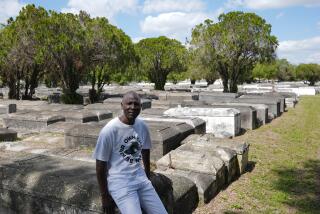O’Hare Covets Final Destinations
- Share via
BENSENVILLE, Ill. — Up a narrow gravel access road in this century-old village -- nestled among the trees, flowering shrubs and the smell of jet fuel -- is Rest Haven Cemetery. Go a bit farther, and there is St. Johannes Cemetery. An electric fence stands between the wooden cross marking the entrance to the 155-year-old graveyard and a runway at O’Hare International Airport. The words on many of the headstones, messages of faith carved in German, have faded away.
But the signs posted outside each graveyard are perfectly clear: “The O’Hare Modernization Program will require the relocation of this cemetery.”
Rest Haven and St. Johannes sit in the path of Chicago’s $15-billion O’Hare expansion plan, which calls for building a new runway and overhauling existing ones to make them more efficient.
The work, which awaits preliminary approval by the Federal Aviation Administration, is slated to begin next year and be completed by 2013.
But not if the parishioners of St. John’s United Church of Christ -- which manages St. Johannes -- and the Rest Haven Cemetery Assn. have anything to say about it.
Several of the Lutheran churchgoers, the association and villages of Bensenville and nearby Elk Grove have filed a lawsuit to block the expansion. The plan, they said in court papers, violated several state laws that protected property owned by religious organizations.
“The idea of the city coming in here with a shovel and digging up my family is an abomination,” said Bob Sell, 39, a church member who has about 100 relatives buried at St. Johannes Cemetery. “There are abolitionists and Civil War veterans buried in these graveyards. This is our history and an integral part of our faith. These people are buried in consecrated ground, and they are not to be disturbed.”
While the issue makes its way through the courts, Chicago officials have gone ahead and hired a company to relocate the estimated 1,600 graves to an as-yet-to-be-identified location. “There are strict guidelines regarding relocating gravesites that we intend to follow,” city spokesman Roderick Drew said.
Federal officials said the expansion was necessary because O’Hare and Midway International -- the region’s other major airport -- have not been able to accommodate all the flights passing through Chicago, which has caused air traffic to back up across the country.
When flight delays nationwide reached an all-time high this year, the FAA demanded that the airlines do something about it. Those serving O’Hare agreed to trim their flight schedules from as many as 110 arrivals per hour to 88 during peak times.
The reduced schedules, which began Monday, are set to last for six months.
Federal officials also announced that brighter lights and upgraded navigation equipment would be installed for two of O’Hare’s runways to decrease flight delays during bad weather.
Although those measures might ease the congestion, officials said, they were temporary fixes until the O’Hare expansion was complete.
In addition to relocating the gravesites, the expansion plan calls for more than 500 houses and dozens of businesses to be knocked down and paved over in the suburbs of Des Plaines, Elk Grove Village and Bensenville.
“How can you physically move these graves?” Sell said. “With the modern burials, you have metal caskets. But a hundred years ago, they didn’t use metal. They used wood. What’s left of that now?”
In the mid-1800s, German immigrants were drawn to this area’s thick forests, seeing their potential for milling and the Salt Creek River as a means of shipping lumber to Chicago.
The newcomers, who followed an evangelical branch of Lutheranism, started several churches. St. John’s was built next to the two cemeteries, near a settlement then known as Dunkley’s Grove.
In the 1950s, church officials -- approached by the city of Chicago with an earlier O’Hare expansion plan -- agreed to relocate their building several miles away in Bensenville. But they refused to move the gravesites “because they believe if you disturb the bodies, you are violating their spirit,” said Joseph Karaganis, plaintiff’s attorney in the current case. So the city expanded the airport to the edge of St. Johannes’ lawn.
The lawsuit to stop the current expansion plan said that removing the bodies from the cemeteries was a violation of the families’ religious rites, their 1st Amendment rights, and conflicted with federal and state religious restoration acts.
The law stated that the government must demonstrate both a compelling need and a lack of alternatives before it could impose a substantial burden on a religious community, Karaganis said. “There are alternatives out there. The city just doesn’t want to talk about them,” Karaganis said.
Chicago officials said they had the right to relocate the cemeteries, thanks to the O’Hare Modernization Act. Passed in 2003, the Illinois law singled out St. Johannes and Rest Haven, and stated that Chicago was exempt “from numerous provisions of the law concerning cemeteries and the removal of those gravesites.”
Religious groups throughout the state have protested the legislation.
“We don’t have a problem with the city expanding O’Hare. We have a problem with how they’re doing it,” said the Rev. David Anderson, executive director of the Illinois Conference of Churches, a statewide ecumenical organization that represents 15 denominations.
“This law gives the city arbitrary ... power to act against any religious body, whether for commercial or political reasons,” Anderson said. “It is dangerous to give any city, let alone Chicago, that kind of authority.”
More to Read
Sign up for Essential California
The most important California stories and recommendations in your inbox every morning.
You may occasionally receive promotional content from the Los Angeles Times.













